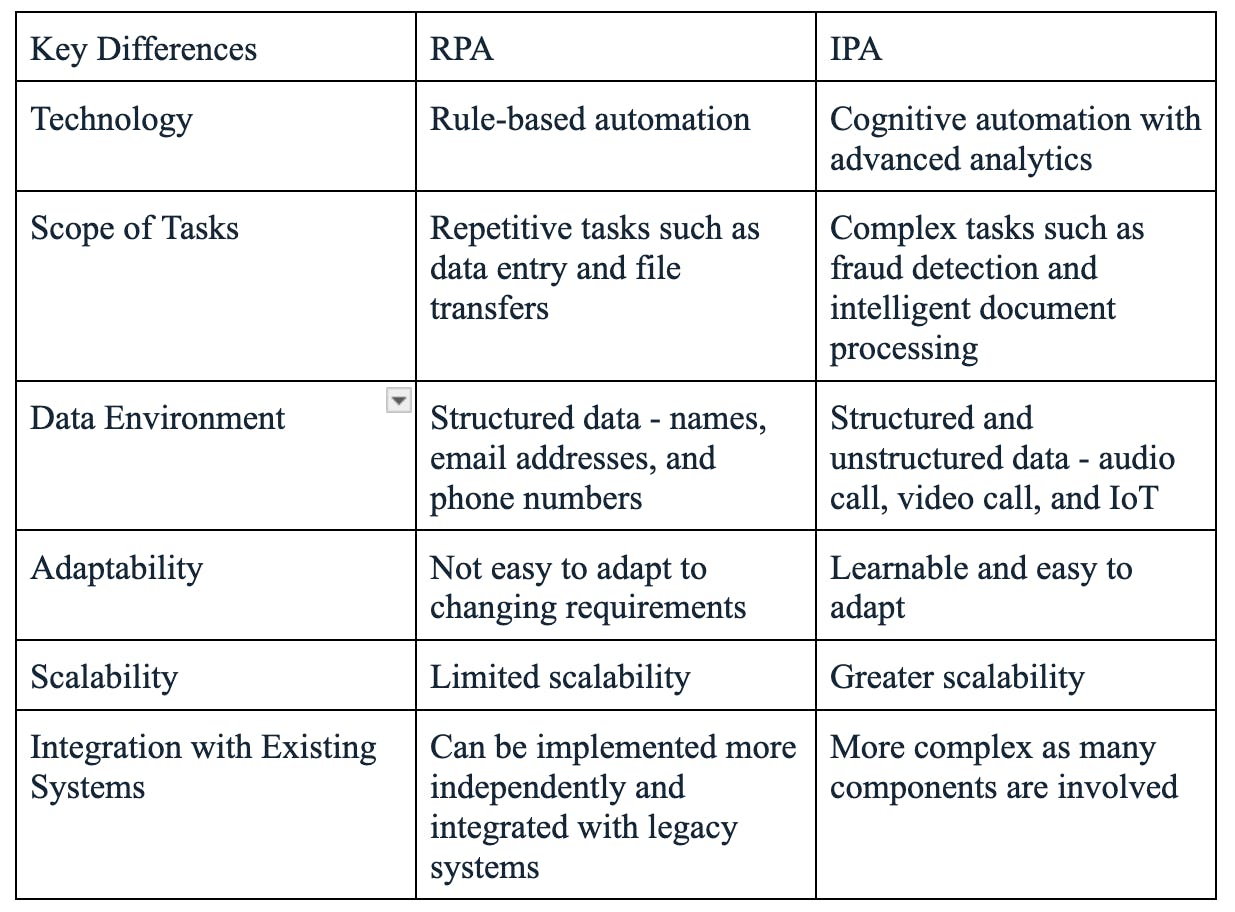In today’s hyper-competitive business environment, organizations are under immense pressure to improve profit margins, enhance customer experiences, and ensure better returns on investment. The growing push for digital transformation has opened the door to next-gen automation solutions that redefine how companies operate. Among these innovations, Intelligent Process Automation (IPA) has emerged as a groundbreaking technology combining artificial intelligence (AI), machine learning (ML), and robotic process automation (RPA) to deliver intelligent, scalable, and efficient business processes.
According to McKinsey, automation technologies like IPA can increase productivity in global business processes by up to 30% and reduce operational costs by 25% to 60%.
What is Intelligent Process Automation (IPA)?
Intelligent Process Automation (IPA) is the convergence of advanced technologies—AI, ML, RPA, natural language processing (NLP), and computer vision—to automate end-to-end business processes. Unlike traditional automation, IPA can interpret unstructured data, learn from patterns, and make decisions in real-time, making it a powerful ally for businesses seeking agility and resilience.
Core Components of IPA:
- Robotic Process Automation (RPA): Automates repetitive, rule-based tasks.
- Artificial Intelligence (AI): Mimics human intelligence for decision-making.
- Machine Learning (ML): Enables continuous learning from data.
- Natural Language Processing (NLP): Understands and processes human language.
- Computer Vision: Interprets visual information such as scanned documents or images.
The Evolution Beyond RPA
Traditional RPA automates rule-based tasks but lacks adaptability. For example, it can extract phone numbers from a form only if the input is correctly placed. Any deviation causes failure. IPA, on the other hand, leverages AI and cognitive technologies to handle ambiguity, unstructured data, and decision-making processes.
This shift from simple automation to intelligent automation empowers organizations to transform their operations holistically.
Intelligent Process Automation (IPA) vs. Robotic Process Automation (RPA)

Benefits of Intelligent Process Automation (IPA)
1. Understanding and Using Unstructured Data
IPA can interpret documents, images, and audio using technologies like Optical Character Recognition (OCR). It transforms unstructured data into structured formats, feeding it into traditional RPA pipelines.
“The goal of automation is not to dehumanize operations but rather to reprioritize them so human creativity can thrive.” — Steve Smith, Forbes Councils Member
2. Reducing Operational Costs
With IPA, companies can automate high-volume processes, reduce human error, and lower operational costs. Gartner notes that intelligent business process automation can save 20% to 30% of operational expenses.
3. Continuous Improvement
IPA solutions use machine learning to optimize performance over time. The more they interact with data, the smarter they get—eliminating the need for constant human supervision.
4. Scalability and Flexibility
IPA can be easily integrated with existing digital ecosystems and scaled as the business grows. It supports dynamic changes in workflows without heavy IT involvement.
5. Enhanced Customer Experience
Faster and more accurate processes mean better service delivery, reduced response times, and higher customer satisfaction scores.
Intelligent Process Automation Use Cases
1. Customer Data Collection
Instead of agents manually gathering customer data, IPA systems extract relevant details from emails, phone transcripts, CRM entries, and external platforms in real-time.
2. Insurance Claims Processing
IPA tools scan paper-based claims, extract key information, and automatically populate CRM systems. For example, Royal Exchange General Insurance Company (REGIC) reduced claim approval time from weeks to hours using IPA.
REGIC Results:
- Process cycle time reduced from 2-3 days to 10 minutes
- 70% of operations automated
- 545 claims processed in 3 months
3. Shipping and Logistics Optimization
IPA analyzes historical shipping data and external factors like weather and traffic to optimize delivery schedules, reduce delays, and improve resource allocation.
4. Finance and Accounting
IPA automates invoice processing, expense management, and regulatory compliance. It eliminates manual entry, reduces errors, and ensures faster reconciliations.
5. Human Resources (HR)
IPA automates onboarding, leave approvals, payroll, and performance evaluations, freeing HR teams to focus on strategic initiatives.
6. Manufacturing and Supply Chain
IPA ensures real-time tracking of inventory, automates procurement, and manages supplier interactions based on predefined triggers.
Technology Advancements Driving IPA
Hyperautomation
Coined by Gartner, hyperautomation is an extension of IPA that combines multiple technologies—AI, RPA, ML, and analytics—to automate every possible business process.
Cognitive Automation
Cognitive automation takes IPA a step further by mimicking human judgment using AI and cognitive computing, capable of reasoning, learning, and decision-making.
Blockchain and IoT
These technologies support IPA by providing secure, verifiable data streams and automating machine-to-machine communication in manufacturing and logistics.
Edge Computing
Improves latency and efficiency by processing data closer to the source, making real-time automation in industrial and retail environments more feasible.
How to Start Your IPA Transformation Journey
- Business Process Modeling and Mapping Understand your current workflows, pain points, and automation potential.
- Choose the Right IPA Platform Select platforms that offer low-code/no-code environments, AI integration, and scalability (e.g., Kissflow, UiPath, Blue Prism).
- Process Reengineering Redefine processes to align with digital workflows and eliminate redundancies.
- Pilot Programs and Scaling Start small with high-impact use cases and scale automation based on proven success.
- Continuous Improvement Use analytics and user feedback to refine and improve automation over time.
Case Study: Damamax’s IPA Success
Damamax, a telecom provider, faced issues with IT infrastructure and inefficient manual workflows. By adopting Kissflow’s low-code IPA solution, they achieved:
- 100% automation in HR and sales workflows
- Increased team productivity
- Elimination of manual errors
- Significant time and cost savings
Damamax continues to automate purchase requests, sales leads, and approvals, setting a benchmark in telecom process efficiency.
The Future of Intelligent Process Automation (IPA)
The future of IPA lies in deeper AI integration, self-healing processes, and predictive analytics. According to Deloitte, 74% of companies currently exploring IPA plan to scale their automation efforts within the next 3 years.
Emerging Trends:
- AI-Augmented Workflows that guide human decisions
- Digital Twins to simulate processes before execution
- No-Code/Low-Code IPA Solutions for faster deployment
- Autonomous Decision Engines that take real-time actions based on predictive insights
Conclusion
Intelligent Process Automation (IPA) is not just a technological upgrade—it’s a strategic necessity. By integrating AI, ML, and RPA into cohesive workflows, businesses can unlock unprecedented efficiencies, reduce costs, and enhance customer satisfaction. As automation technologies evolve, organizations that invest in IPA today will be best positioned to lead the future of digital transformation.
Whether you’re in finance, manufacturing, healthcare, or logistics, IPA offers a path to innovation, agility, and long-term success. The time to embrace intelligent automation is now.
Ready to transform your business with IPA? Explore leading platforms and start your journey today.
